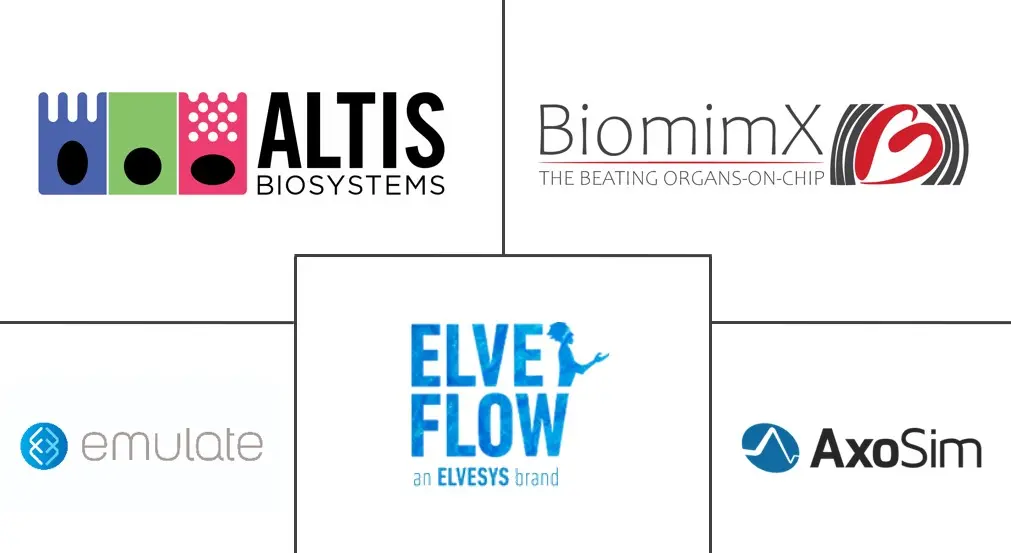Organ-on-chip Market Size and Share
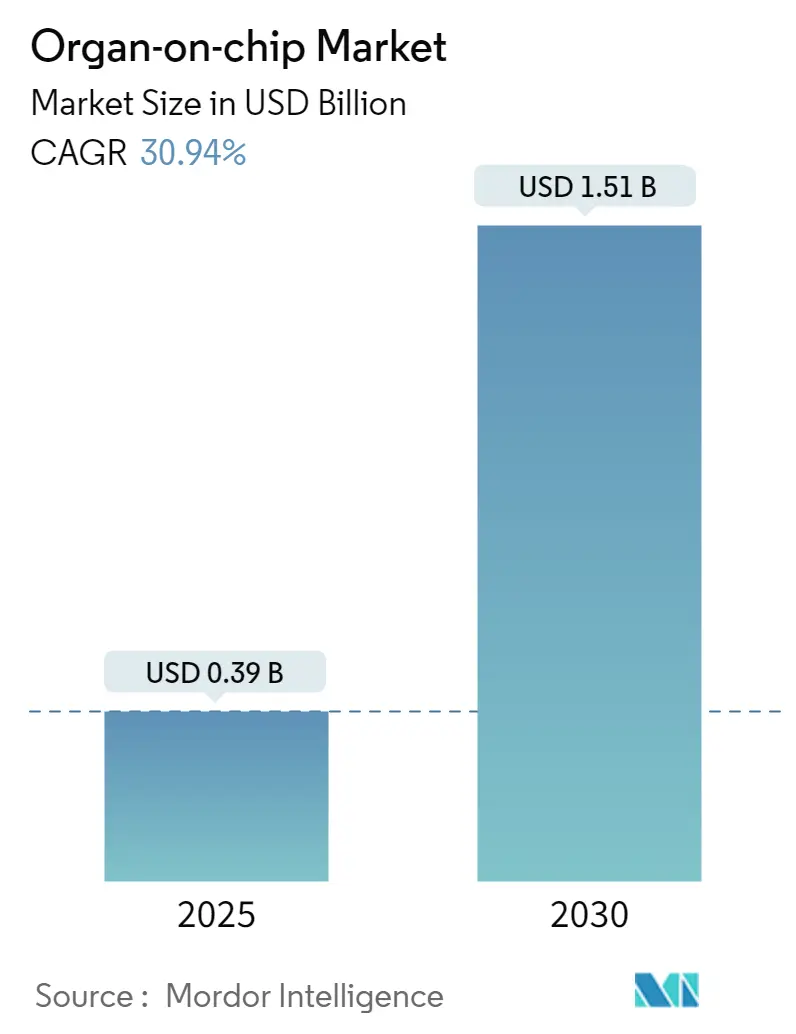
Organ-on-chip Market Analysis by Mordor Intelligence
The Organ-on-chip Market size is estimated at USD 0.39 billion in 2025, and is expected to reach USD 1.51 billion by 2030, at a CAGR of 30.94% during the forecast period (2025-2030).
Demand is rising as regulators validate microphysiological systems, pharmaceutical firms redirect R&D funds toward animal-free testing, and 3D printing lowers device fabrication costs. Early commercial traction is strongest in North America, where the FDA Modernization Act 2.0 and the ISTAND Pilot Program have shortened approval timelines. Asia-Pacific is set for the fastest expansion on the back of heavy public spending, while Europe benefits from standardization roadmaps that ease cross-border adoption. Competitive intensity is growing as companies integrate artificial intelligence, strike co-development deals, and scale automated production lines.
Key Report Takeaways
- By organ type, lung models led with 34.8% of organ-on-chip market share in 2024; heart chips are projected to grow at a 33.4% CAGR through 2030.
- By application, drug discovery platforms accounted for 58.2% of the organ-on-chip market size in 2024, while disease modeling is set to expand at a 34.6% CAGR to 2030.
- By end user, pharmaceutical and biotechnology companies held 59.7% of the organ-on-chip market share in 2024; contract research organizations are positioned for the highest 36.8% CAGR between 2025-2030.
- By geography, North America dominated with 42.8% revenue share in 2024, whereas Asia-Pacific is forecast to register a 35.3% CAGR to 2030.
Global Organ-on-chip Market Trends and Insights
Drivers Impact Analysis
| Driver | (~) % Impact on CAGR Forecast | Geographic Relevance | Impact Timeline |
|---|---|---|---|
| Animal-free preclinical testing mandates | +7.5% | North America, Europe | Medium term (2-4 years) |
| Burden of chronic and complex diseases | +6.2% | Developed healthcare markets | Long term (≥ 4 years) |
| Precision medicine & patient-derived chips | +5.8% | North America, Europe, Japan, South Korea | Medium term (2-4 years) |
| Early detection of drug toxicity | +4.3% | Regions with strong pharmaceutical R&D | Short term (≤ 2 years) |
| Strategic investments & partnerships | +3.9% | North America, Europe, China | Short term (≤ 2 years) |
| Microfabrication & 3D bioprinting advances | +3.2% | Global innovation hubs | Medium term (2-4 years) |
| Source: Mordor Intelligence | |||
Global Shift Toward Animal-Free Preclinical Testing Mandates
The FDA’s decision in October 2025 to phase out compulsory animal studies for monoclonal antibodies, coupled with the FDA Modernization Act 2.0, is accelerating uptake of human-relevant test beds.[1]U.S. Congress, “FDA Modernization Act 2.0,” congress.gov The agency’s pilot program that lets developers submit non-animal data has prompted pharmaceutical groups to revise internal protocols and divert screening budgets to organ chips. Europe is moving in parallel as regulators tighten restrictions on animal research. These policy moves create a stable demand floor, drive procurement frameworks among contract research organizations, and shorten sales cycles for platform vendors. Firms that combine chips with AI-enabled analytics stand to benefit most because they offer a turnkey path that aligns with post-2025 compliance deadlines. The animal-free mandate therefore anchors medium-term revenue visibility in the organ-on-chip market.
High Burden of Chronic & Complex Diseases Requiring Better Models
Chronic disorders such as metabolic syndrome, non-alcoholic fatty liver disease, and neurodegenerative conditions account for an expanding share of global morbidity. A 2024 study using Hesperos’ multi-organ chip replicated NAFLD progression and highlighted therapeutic windows that animal models miss.[2]Hesperos Inc., “Human-on-a-Chip NAFLD Study,” nature.com This ability to mimic human pathophysiology supports go-no-go R&D decisions and lowers clinical attrition costs. Demand is especially pronounced in markets with aging populations and sizable public insurance schemes, which now prioritize translational research that directly benefits patient outcomes. As these health systems push for higher predictive validity, organ chips emerge as indispensable tools, sustaining long-term momentum in the organ-on-chip market.
Rising Demand for Precision Medicine & Patient-Derived Chips
Personalized oncology and rare-disease programs rely on test systems that capture individual heterogeneity. Researchers at Columbia University have built customizable multi-organ constructs linking heart, bone, liver, and skin tissues through vascular flow. By loading patient-specific cells, clinicians can benchmark therapeutic regimens before first-in-human dosing. Uptake is most evident at comprehensive cancer centers in the United States, Japan, and Germany, where reimbursement agencies are piloting outcome-based contracts that reward tailored interventions. This clinical pull continues to widen addressable use cases and cements organ-on-chip technology as a core pillar of precision medicine.
Need for Early Detection of Drug Toxicity and New Product Launches
Drug-induced liver injury accounts for nearly 40% of late-stage failures. The FDA’s acceptance of a human Liver-Chip into the ISTAND Pilot Program in September 2024 provides a validated route for toxicity claims.[3]U.S. Food and Drug Administration, “ISTAND Pilot Program Acceptance of Human Liver-Chip,” fda.gov CN Bio’s PhysioMimix Bioavailability assay kit, launched in November 2024, complements these efforts by assessing oral absorption under dynamic flow conditions. Together, regulatory endorsement and novel assays incentivize sponsors to integrate chips earlier in discovery. The resulting shift in workflow keeps short-term growth in the organ-on-chip market on track.
Restraints Impact Analysis
| Restraint | (~) % Impact on CAGR Forecast | Geographic Relevance | Impact Timeline |
|---|---|---|---|
| Technical complexity & skill gap | −5.4% | Emerging markets | Medium term (2-4 years) |
| High capital & operating costs | −4.8% | Resource-limited regions | Short term (≤ 2 years) |
| Limited regulatory validation & guidelines | −3.6% | Regions with evolving frameworks | Medium term (2-4 years) |
| High CapEx for automated tool-chains | −3.2% | Emerging markets | Short term (≤ 2 years) |
| Source: Mordor Intelligence | |||
Technical Complexity & Skill Gap Hindering Broad Adoption
Operating microfluidic platforms demands cross-disciplinary expertise in cell biology, engineering, and sensor integration. A May 2024 review in Frontiers in Lab-on-a-Chip Technology surveyed smaller laboratories and found limited access to trained personnel and standardized protocols. Multi-organ systems exacerbate the burden because each module requires tight flow control and synchronized data capture. To bridge the gap, industry groups advocate modular devices, automated media exchange, and cloud-based analytics. Yet, until these tools become mainstream, complexity will temper uptake, particularly outside tier-one research hubs.
High Capital & Operating Costs of Microfluidic Infrastructure
Precision pumps, gas-controlled incubators, and high-content imaging add significant overhead. Consumables, frequent sterilization, and the need for skilled technicians inflate per-assay expenses. While LCD 3D printing has trimmed unit costs, many institutions still face budget constraints. Venture-backed startups can amortize equipment, but publicly funded labs often struggle to justify the initial outlay. As price compression proceeds, the organ-on-chip market will broaden, yet short-term adoption remains uneven.
Segment Analysis
By organ type: Lung dominance and cardiac acceleration
Lung chips commanded 34.8% of the organ-on-chip market share in 2024 due to their utility in respiratory toxicity, infectious-disease research, and aerosol delivery studies. The launch of high-fidelity 3D-bioprinted alveolar constructs by POSTECH researchers has strengthened model relevance and drawn funding from vaccine makers. These platforms mimic airway biomechanics, enable endpoints such as ciliary beat frequency, and integrate immune cell layers. With regulatory agencies prioritizing respiratory-drug safety following COVID-19, procurement remains steady. In parallel, heart-on-chip devices are on track for the fastest 33.4% CAGR through 2030, driven by arrhythmia screening and cardiotoxicity testing for oncology compounds. Automated fabrication that embeds force-sensing microwires reduces hands-on time and encourages broader deployment across academic core facilities.
The brain and central-nervous-system subsegment is gaining momentum as researchers seek alternatives to rodent models in neurodegenerative research. Kidney- and liver-based chips hold strong positions; the latter benefits from the ISTAND-validated human Liver-Chip, which anchors safety packages for metabolic candidates. Multi-organ arrays linking vascular, epithelial, and immune components represent the next frontier. Vendors that offer ready-to-use, modular plates stand to capture incremental orders as sponsors move toward systemic pharmacology studies.
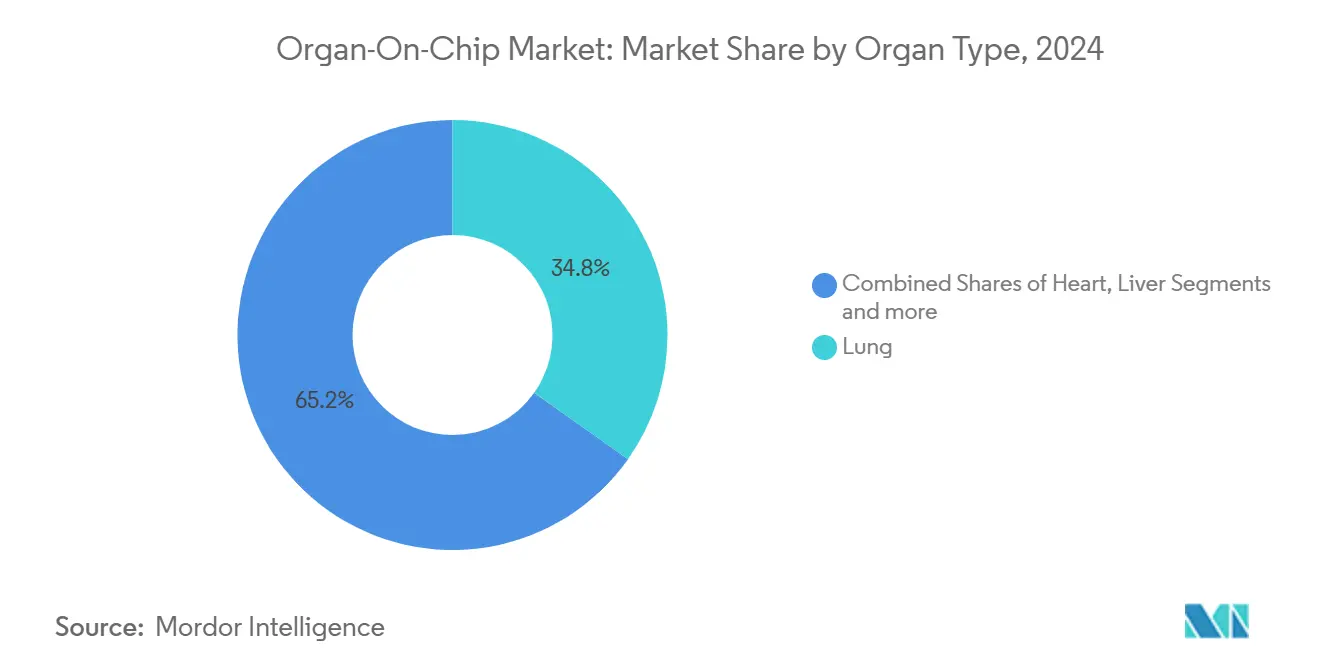
Note: Segment shares of all individual segments available upon report purchase
By application: Drug discovery leadership and disease modeling momentum
Drug discovery remained the largest use case, representing 58.2% of organ-on-chip market size in 2024. Sponsors employ chip-based phenotypic screens to filter chemical libraries before investing in animal studies. The resulting hit-to-lead refinement lowers expenditure on low-probability compounds and shortens go-to-clinic timelines. Disease modeling, although smaller, is expanding at a 34.6% CAGR through 2030 as advanced chips recreate complex pathologies such as non-alcoholic steatohepatitis and inflammatory bowel disease. These systems support mechanism-of-action research and biomarker validation, activities that traditional cultures cannot replicate under dynamic perfusion.
ADME and toxicology workflows use liver, kidney, and gut constructs to estimate bioavailability, metabolic clearance, and off-target liabilities. The FDA’s focus on drug-induced liver injury metrics, combined with CN Bio’s newly launched bioavailability kit, signals official acceptance of chip-derived PK data. Precision-medicine deployments remain niche but are gaining clinical traction, especially in oncology where ex vivo tumor chips inform personalized regimens for refractory patients. Infectious-disease models that simulate pathogen entry across mucosal barriers round out the application portfolio.
By end user: Pharma strength and CRO dynamism
Pharmaceutical and biotechnology companies accounted for 59.7% organ-on-chip market size in 2024 as they integrate microphysiological data into regulatory dossiers for new chemical entities. Internal labs run comparative studies that position chip read-outs alongside historical animal results, gradually phasing out legacy assays. Budgets earmarked for predictive toxicology and first-in-class modalities sustain recurring demand for consumables and software analytics.
Contract research organizations are forecast to outpace all other groups with a 36.8% CAGR to 2030. These service providers act as force multipliers for small and mid-cap sponsors that lack in-house microfluidic capacity. Several CROs have installed turnkey systems from Emulate and MIMETAS to expand fee-for-service menus covering cardiotoxicity, permeability, and disease modeling. Academic institutes continue to pioneer novel chip architectures, often spinning out venture-backed firms. Cosmetics and personal-care brands are piloting skin-on-chip assays to meet regulations that restrict animal testing, adding diversification to the demand base.
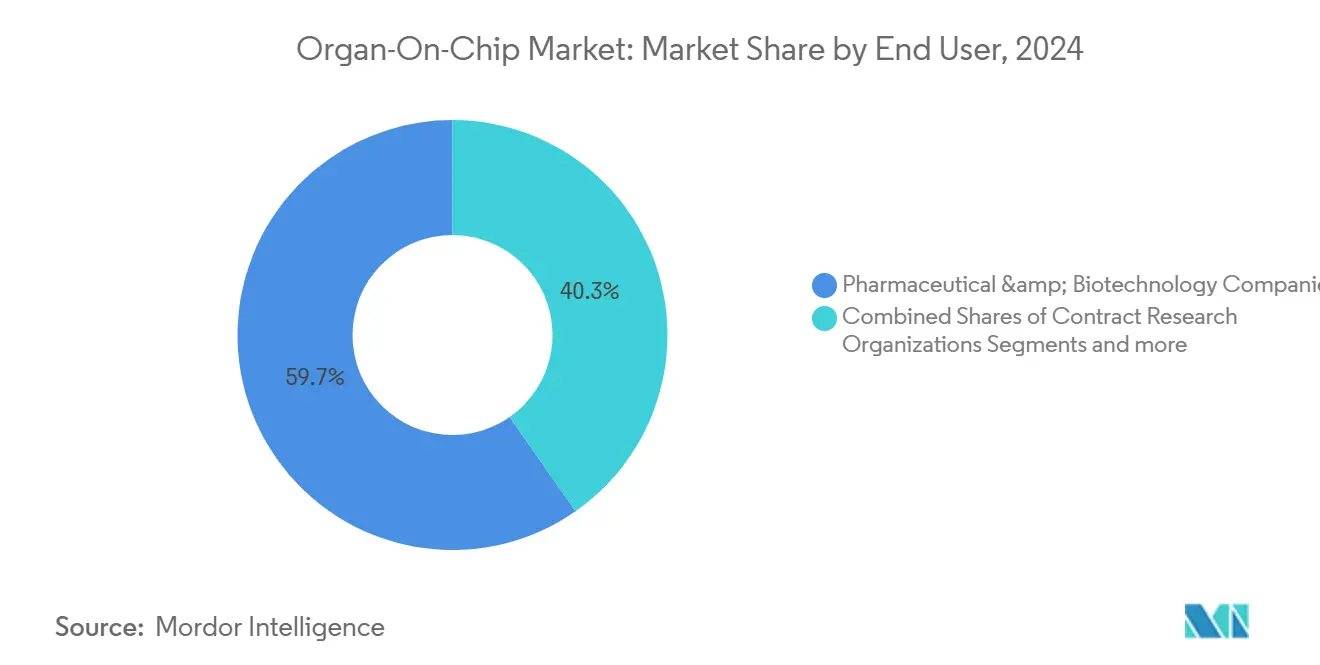
Note: Segment shares of all individual segments available upon report purchase
Geography Analysis
North America generated 42.8% of 2024 revenue for the organ-on-chip market, buoyed by the FDA’s ISTAND framework, deep venture pools, and collaborations between Ivy League universities and big pharma. The United States hosts most early-stage chip trials, while Canada supplies polymer microfabrication expertise that feeds contract manufacturers. Reimbursement pilots under Medicare’s coverage-with-evidence paradigm further encourage hospital-based translational studies.
Asia-Pacific is on course for the swiftest 35.3% CAGR through 2030. China leverages state grants that subsidize microfluidic tooling, and its contract research ecosystem scales at speed to handle multinational outsourcing. Japan’s Pharmaceuticals and Medical Devices Agency has issued guidance on microphysiological data submissions, giving local developers a route to domestic approval. South Korean consortia align chip production with national initiatives in cell and gene therapy, creating synergistic demand.
Europe maintains a robust share powered by Horizon Europe grants and a consolidated academic network. The CEN/CENELEC roadmap published in July 2024 maps pathways for material qualification, sterilization, and cell integrity that foster cross-lab comparability. France and Germany finance industry clusters that pair nanoscale engineering with primary human-cell banks. The region’s stringent animal-welfare rules accelerate substitution of in vivo assays with chip models, especially in safety pharmacology and cosmetics.
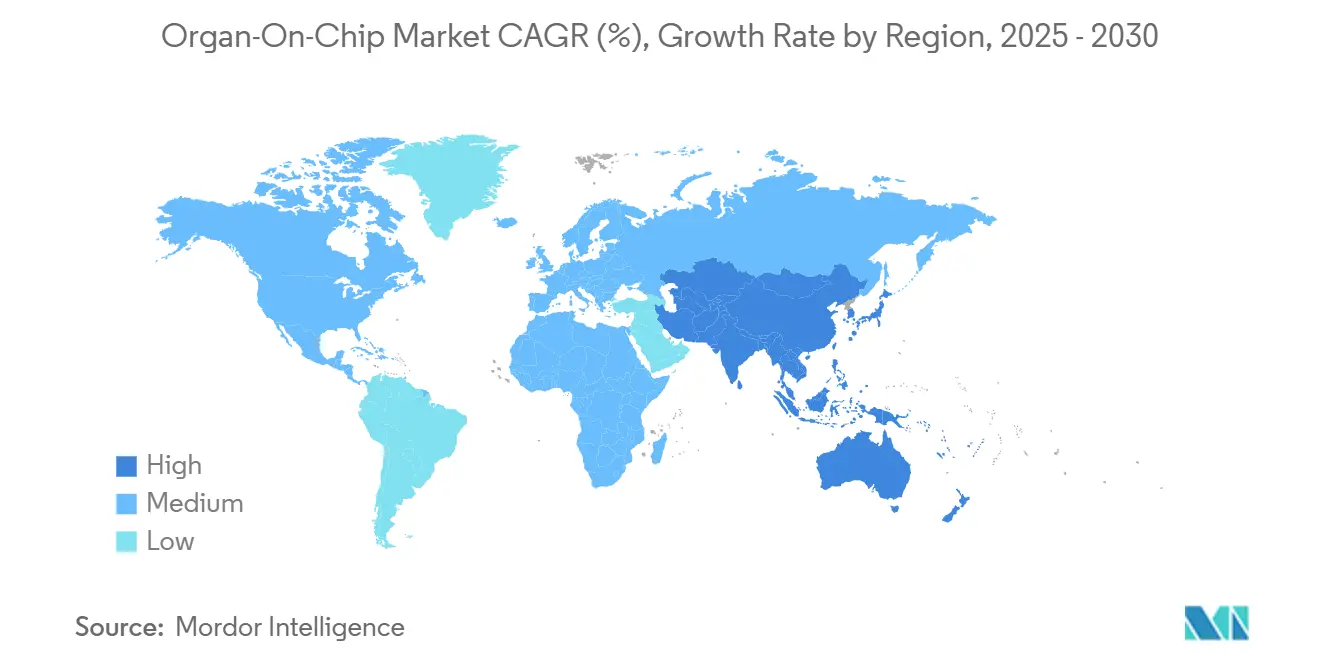
Competitive Landscape
The organ-on-chip market is moderately fragmented, with over a dozen platform vendors, specialized component suppliers, and analytics startups. CN Bio’s tie-up with Altis Biosystems in January 2024 merged gut epithelium modules with liver constructs, delivering a PK-PD suite that addresses first-pass metabolism. Emulate licenses its hardware under multi-year contracts and bundles cloud analytics to lock in recurring subscription revenue. MIMETAS extends its OrganoPlate catalogue to kidney models, strengthening renal-toxicity coverage.
Funding rounds fuel product roadmaps and expansion. CN Bio’s Series B and Emulate’s multi-round pool support ISO-class clean-room capacity increases. New entrants such as BMF Biotechnology apply high-resolution 3D printing to create organ scaffolds, challenging incumbents on pricing. Artificial intelligence integration forms a competitive moat; Quris-AI’s Bio-AI platform, adopted by Merck KGaA, illustrates the appeal of machine-learning-ready datasets. White-space remains in multi-organ chips for immuno-oncology and rare genetic disorders, where few validated test beds exist. Vendors that build open, modular ecosystems can capture these unmet needs.
Strategic moves in 2025 include cross-licensing of sensor technologies, OEM agreements for pump assemblies, and partnerships with electronic-health-record vendors to streamline data import. Collectively, these actions deepen switching costs, widen solution breadth, and spur consolidation as firms seek scale efficiencies.
Organ-on-chip Industry Leaders
-
BiomimX SRL
-
Elveflow
-
Emulate Inc.
-
Altis Biosystems
-
AxoSim
- *Disclaimer: Major Players sorted in no particular order
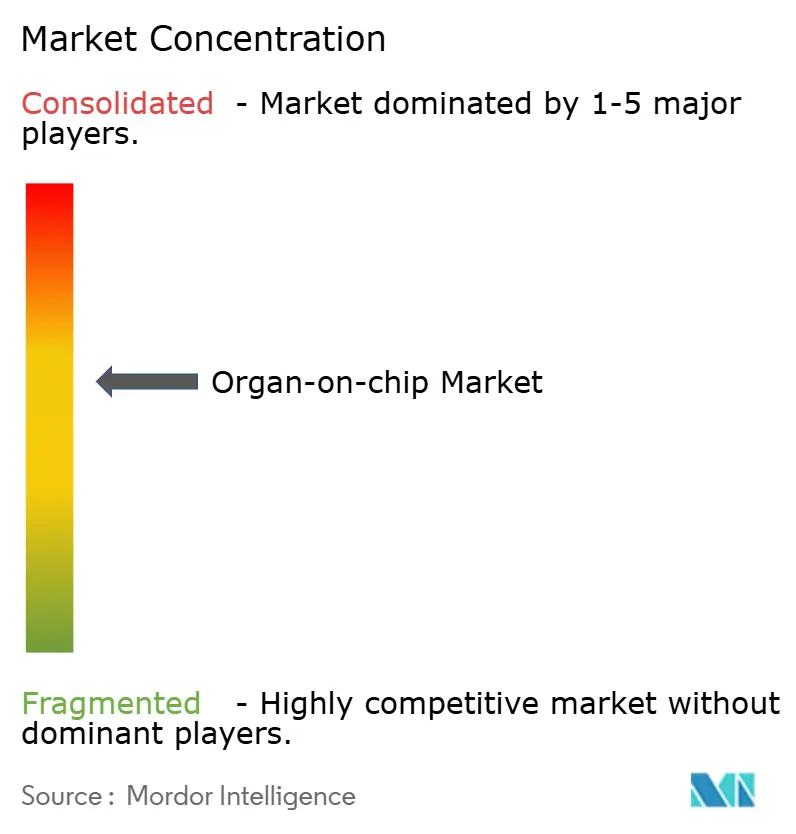
Recent Industry Developments
- October 2024: InSphero launched a next-generation liver-on-a-chip platform designed to improve the assessment of drug-induced liver injury, providing more reliable data for preclinical studies
- October 2024: Allevi Inc. introduced a new bioprinting kit tailored for creating customizable organ-on-chip models, streamlining the process for researchers to fabricate tissue-specific chips.
- September 2024: Hesperos secured a significant grant to develop a multi-organ-on-a-chip system aimed at modeling complex human diseases, enhancing the potential for personalized medicine applications.
- September 2024: Emulate Inc. announced a collaboration with a leading pharmaceutical company to utilize their Organ-on-Chip technology for advanced drug testing, aiming to enhance predictive accuracy in human biology models.
- August 2024: MIMETAS BV expanded its OrganoPlate platform to include a kidney-on-a-chip model, facilitating more accurate studies of renal diseases and drug nephrotoxicity
Research Methodology Framework and Report Scope
Market Definitions and Key Coverage
Our study defines the organ-on-chip market as all micro-engineered, microfluidic devices that culture live human or animal cells in three-dimensional channels to replicate full-organ physiology for research, toxicity testing, and early-stage drug development. The baseline captures revenue from finished chips, integrated instruments, essential consumables, and associated custom or standard services.
Scope exclusion: stand-alone organoid culture plates without integrated microfluidic flow are outside the present scope.
Segmentation Overview
- By Organ Type
- Liver
- Heart
- Lung
- Kidney
- Intestine
- Brain & CNS
- Skin
- Multi-Organ & Other Complex Systems
- By Application
- Drug Discovery & Lead Identification
- ADME/Toxicology Screening
- Disease Modeling
- Precision Medicine & Personalized Therapy
- Other Applications
- By End User
- Pharmaceutical & Biotechnology Companies
- Contract Research Organizations
- Academic & Research Institutes
- Cosmetics & Personal Care Industry
- Other End Users
- By Geography
- North America
- United States
- Canada
- Mexico
- Europe
- Germany
- United Kingdom
- France
- Italy
- Spain
- Rest of Europe
- Asia-Pacific
- China
- Japan
- India
- Australia
- South Korea
- Rest of Asia-Pacific
- Middle East & Africa
- GCC
- South Africa
- Rest of Middle East & Africa
- South America
- Brazil
- Argentina
- Rest of South America
- North America
Detailed Research Methodology and Data Validation
Primary Research
Interviews and structured surveys with microfluidic engineers, pharma toxicologists, CRO procurement leads, and venture investors across North America, Europe, and Asia refined market adoption curves, average selling prices, and service attachment rates. These conversations let us challenge secondary assumptions, reconcile regional procurement patterns, and capture future volume triggers such as multi-organ platform launches.
Desk Research
Mordor analysts began with public sources such as US FDA Modernization Act 2.0 briefs, NIH/NCATS Tissue Chips program releases, World Intellectual Property Organization patent filings on microfluidics, and trade data from Volza for chip imports to key hubs. We layered these with statistics from the European Commission's Joint Research Centre on alternative test models, scholarly journals in Lab on a Chip, company 10-Ks, and selected Dow Jones Factiva news archives. Paid datasets, D&B Hoovers for supplier financials and Questel for patent citation trends, helped benchmark commercial traction and innovation velocity. The list above is illustrative; many additional sources supported validation and context building.
Market-Sizing & Forecasting
A top-down "drug-development spend substitution" model converts global pre-clinical R&D outlays into an addressable demand pool that we calibrate with organ-specific penetration ratios sourced from primary research. Supplier roll-ups of chip shipments and sampled ASP × volume checks provide a selective bottom-up cross-check before totals are locked. Key variables include the number of FDA Phase I starts, annual microfluidic patent grants, venture funding rounds in OoC start-ups, and academic publication counts, each statistically tied to demand using multivariate regression. Scenario analysis adjusts for regulatory acceleration or delays. Data gaps in shipment volumes are bridged through channel checks with distributors and interpolated where variance stayed within +/-7 %.
Data Validation & Update Cycle
Outputs pass three internal reviews: variance screening against independent indicators, senior-analyst logic walkthrough, and a pre-publication refresh. We update every twelve months or sooner if material events, major funding spikes, landmark approvals, or chip recalls, shift baseline assumptions.
Why Mordor's Organ-On-Chip Baseline Earns Trust
Published figures often diverge because each firm chooses different product mixes, adoption curves, and refresh cadences. Buyers deserve clarity on why numbers vary and which one they can lean on.
Key gap drivers include narrower device-only scopes elsewhere, exclusion of service revenues, reliance on single-region shipment surveys, or aggressive uptake multipliers not tested with end users. Mordor's model, by contrast, anchors on globally comparable R&D spend and validates chip volumes through both suppliers and purchasers before applying consensus ASPs.
Benchmark comparison
| Market Size | Anonymized source | Primary gap driver |
|---|---|---|
| USD 0.39 B (2025) | Mordor Intelligence | |
| USD 0.157 B (2024) | Global Consultancy A | Device-only scope; omits custom services and multi-organ platforms |
| USD 0.123 B (2024) | Global Consultancy B | Uses shipment survey from three countries and lower ASP benchmark; limited forecast refresh |
In sum, Mordor's disciplined variable selection, transparent assumptions, and annual validation cycle give decision-makers a balanced, reproducible baseline they can confidently plug into portfolio, funding, or capacity plans.
Key Questions Answered in the Report
What is the projected value of the organ-on-chip market by 2030?
The organ-on-chip market is forecast to reach USD 1.5 billion by 2030, driven by a 30.94% CAGR.
Which organ model currently generates the highest revenue?
Lung chips lead with 34.8% of 2024 revenue, reflecting strong demand in respiratory research and inhalation toxicity testing.
Why are contract research organizations expected to grow fastest?
CROs provide outsourced microphysiological testing services that appeal to sponsors lacking in-house infrastructure, leading to a 36.8% CAGR outlook between 2025-2030.
How are regulators supporting organ-on-chip adoption?
The FDA’s ISTAND Pilot Program accepts chip-generated safety data, while the FDA Modernization Act 2.0 removes animal-test mandates, creating clear pathways for alternative methods.
What technological advances are lowering costs?
LCD 3D printing and automated thermoplastic fabrication have cut per-device production expenses, enabling mass manufacture of high-resolution chips.
Which region will expand the fastest and why?
Asia-Pacific is set for a 35.3% CAGR due to government R&D subsidies, a growing pharmaceutical base, and emerging regulatory guidance that endorses chip data in submissions.
Page last updated on:
